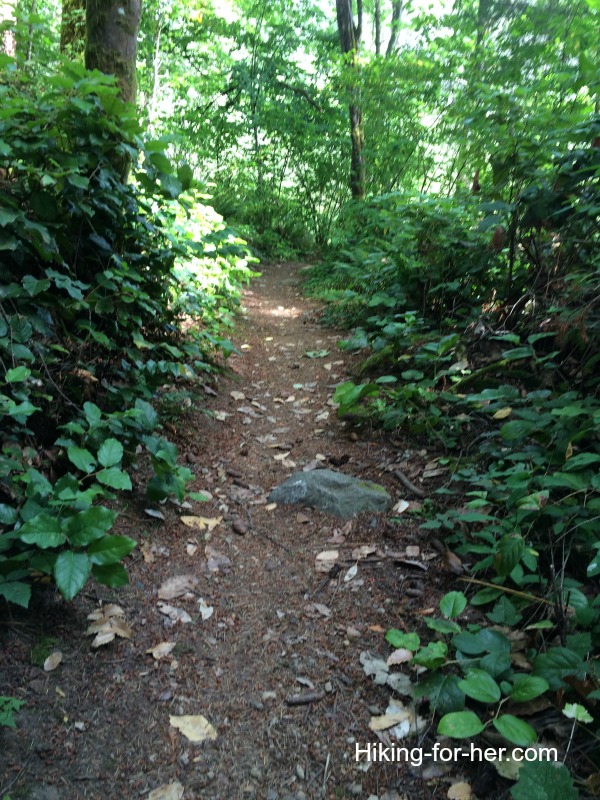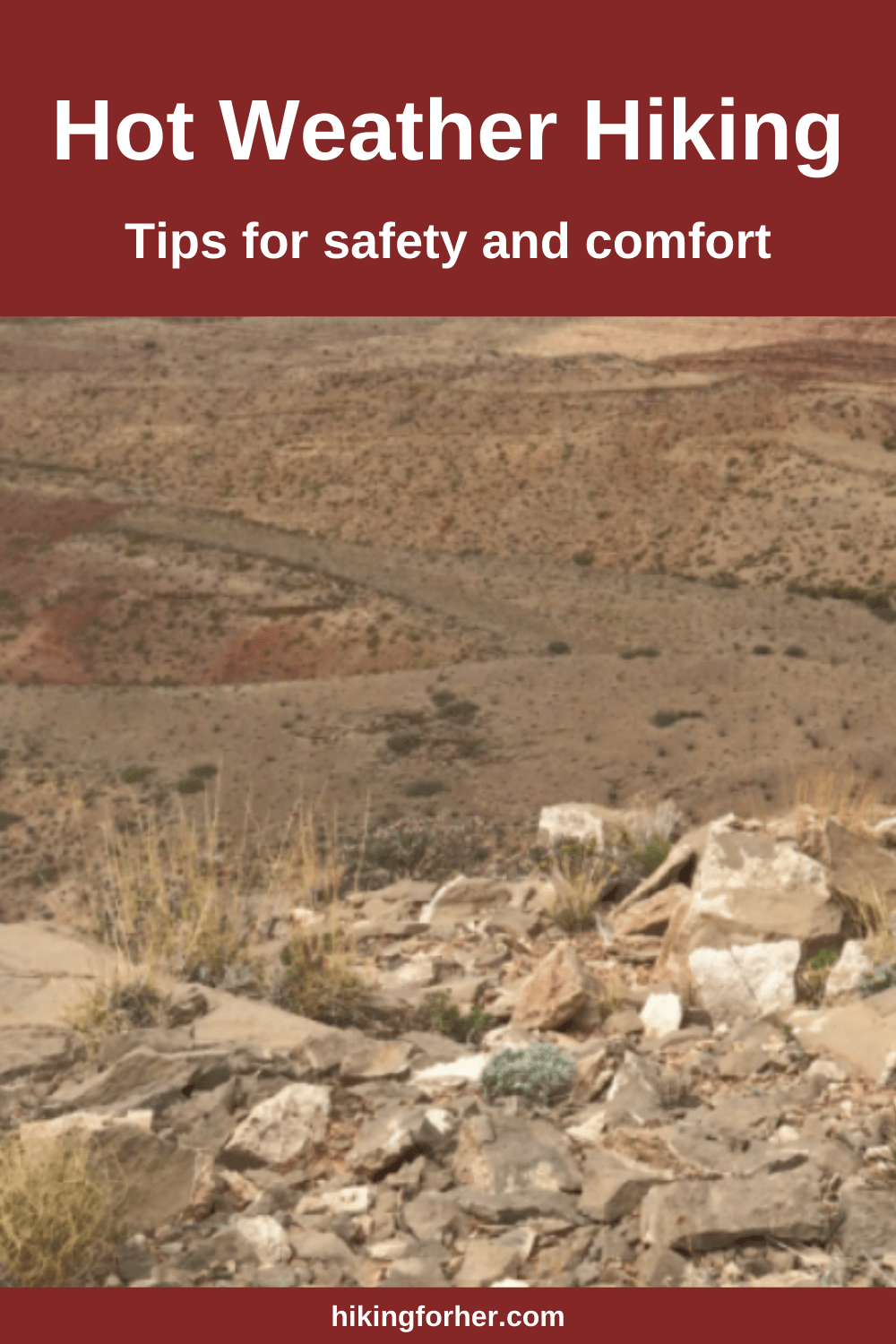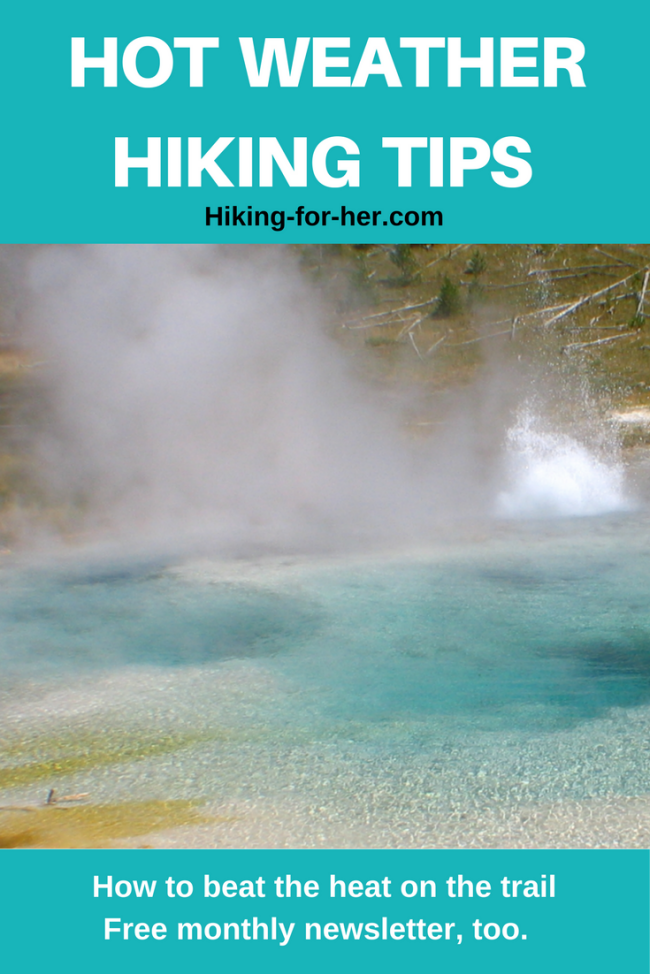
Hot Weather Hiking Tips
For Your Comfort And Safety
By Diane Spicer
It's important to anticipate trail conditions when the season changes.
An easy hike in the cool months of the year can become a beast of a trail when temperatures soar.
These hot weather hiking tips were learned the hard way: going from cool, moist hiking trails like this one in Washington State:

... to hot, dry terrain like this in southern New Mexico.

So trust me when I say that it's quite easy to get caught off guard when you hike in hot weather.
Who knew it could get so blazing hot??
If you live where heat is a reality, you're shaking your head at my naivete, aren't you?
But I would venture a guess that you sometimes might be unprepared for what Mother Nature throws at you when the predicted temperature is far exceeded by reality.
Caught unprepared for hot hiking conditions?
Don't let it happen to you!
Use my best hot weather hiking tips to keep yourself comfortable and safe on a sun scorched, dusty trail.
Because how to hike in hot weather isn't just a simple matter of wearing fewer layers or donning a hiking hat.
Best hot weather hiking tips
begin with a hydration strategy
If you haven't already figured it out, you will once a hot, dry breeze washes over you:
- Hiking in the heat is all about water.
You're just a big bag of water (no offense), and you need to replenish your cellular water supplies constantly with water that you carry or can locate while hiking.
If you skimp on water intake, you risk the perils of dehydration.
If you're not sure what your normal hydration status looks like, keep track of your water drinking habits for a few days well in advance of your hot weather hiking plans.
Here's a quick way to do that
Try my strategy to work more water into your daily habits:
- Put 6 pennies on a windowsill or counter top where you get your water (kitchen sink, refrigerator, water cooler at work, etc.).
- Every time you fill up your cup or bottle with at least one cup of water, take away a penny.
- At the end of your 8 hour work day or time at home, how many pennies are left?
If they're not all safely stowed in your pocket, your hydration status is low.
That's a bad way to begin a hiking trip into a hot weather area.
You're going to have to make a conscious effort to drink more water before you leave for the trail head.
- Never go into a hot weather hiking scenario under hydrated. Your tissues are already working hard to maintain a normal water balance, and you're not helping much.
- Drink water, and only water, the day before your hike. Dehydrating beverages with caffeine and alcohol are not your friends.
- Consider a hiking hydration backpack to ensure you're drinking enough water on your hike.
For more information on dehydration symptoms, read this.
If you do nothing with the rest of these hot weather hiking tips, my hope is that you'll heed the need to hydrate early and often.
Follow up your hydration strategy with behavioral adaptations
The biggest lesson I had to learn when I started hiking in the desert Southwest was this:
You've got to choose your destinations based on the clock,
not the terrain.
Here's what I mean
Getting the earliest start possible, and getting off the trail during the heat of the day, are smart moves for hot weather hiking.
Sunny, blue skies were somewhat of a novelty for me, coming from cloudy northern areas, but I soon learned that I couldn't hike through the heat of the day, with the sun beating down on me, for long.
So I learned to choose my hiking routes with care. If shade was available from rock formations or vegetation, I could risk an all-day hike in the heat. Nap time is not necessarily a bad thing for a hot hiker!
If I was hiking in exposed terrain, starting at the crack of dawn and hitting it hard, then getting off the trail by noon, was the way to go.
Alternatively, starting a hike in the cool of the evening and finishing by headlamp also worked.
It was a huge mindset shift at first, but hey, the animals and plants have it all figured out!

Now I do, too.
And early morning or late evening hikes give you the best chance of seeing wildlife.
For backpacking, things get even more complicated.
The gear I carry for cool, wet conditions is too heavy for hot dry hiking.
- It was a shock to realize that I could use my sleeping bag LINER rather than my down sleeping bag!
Go through all of your gear and eliminate "over kill" items. It's all about water, just as it always is.
But in this situation, it's about getting enough water.
And water is heavy! So make room on your back for lots of it by leaving unneeded items at home.
Hot weather food safety tips
As the temperatures soar inside your food bag, the chance of food borne illness does, too.
- Read this for several strategies to keep your trail food safe to eat in high temperatures.
- When in doubt, don't eat it. And don't leave it for the local population to find (Leave No Trace).
Water: cherish it!
When you do come across surface water, use it to fullest advantage.
Replenish your water supply, using backpacking water purification methods to avoid microscopic trouble makers.
Soak your bandanna or an extra piece of clothing in it, throw the wet item into a zip lock bag, and either use it when you feel overheated or have it as back up in case of heat exhaustion/stroke symptoms (see below).
- My husband is notorious for soaking his hat, filling it with water, and then putting it back on his head. Works great to keep him cool!
Want to be a hiking rebel? Jump into, or sit down in, the water and get completely soaked.
Keep hiking and enjoy evaporative cooling as the heat robs you of the deliciously cool water all over your body.
One area of concern to be aware of as a hiking rebel:
As your clothing dries, it might chafe
your delicate groin and armpit areas, especially if you are wearing
a tight, cotton sports bra or panties.
Two of my most important hot weather hiking tips for you:
- Use BodyGlide at the beginning of the hike, and avoid cotton underwear because it dries slowly.
And here's one more trail behavior to change: Salty trail snacks combined with frequent water breaks are your friend.
What about salt intake?
If you've been taught to avoid salt, relax your salt restrictions during hot weather hiking.
You need the sodium.
- Unless you're on a sodium restricted diet for a medical reason, of course.
- Check things out ahead of time with your medical provider, and ask them for hot weather hiking tips for your situation.
Use UPF sun protective clothing
sunscreen, & sunglasses
Here are some hot weather hiking tips based on technology, rather than behavior.
Any clothing can protect you from ultraviolet radiation, and prevent burning of your skin.
But specially designed UPF sun protective hiking clothing stands up to the challenge of keeping you cool and dry as well.
And no hot weather hiking tips would be complete without a few words about sunscreen and sunglasses.
Know the difference between
heat stroke and heat exhaustion
These hot weather hiking tips might save your life, or help you help your hiking buddy.
Your body will respond to the heat with appropriate measures to keep your internal temperature at a constant level.
That's why you perspire.
But if you overheat your exterior, you put your vital organs at risk as well.
Heat stroke is an emergency
A hiker experiencing heat stroke looks like this:
- Dry skin, a clue that things are not right internally because in the heat you should perspire, right?
- Flushed face, although sometimes hard to detect on a hiker with a darker skin tone or deep tan.
- Confused or irritable demeanor, a marked change from normal behavior.
What needs to happen next is a huge challenge if you're miles from the trailhead and have no one to send for help: this hiker's body needs to be cooled down immediately.
Do whatever it takes to wick heat away from this person's body, including:
- removing clothing
- fanning them with whatever is available (including the removed shirt or pants)
- if at all possible without making your situation worse, dumping water on head and upper body in an attempt to create cooler conditions.
Heat exhaustion
Getting exhausted from hiking in the heat is not quite as dire, but needs to be treated immediately.
An exhausted, hot hiker looks like this:
- Cool, moist skin (that's a great way to rule out heat stroke).
- Exhibits signs of headache, dizziness, nausea or cramps, or will tell you about these symptoms. Be sure to ask.
- Vomiting may also occur.
Any headache while hiking should be treated as a serious matter, but especially in hot weather hiking.
Dig into your food bag for your electrolytes, and add them to a water bottle. The hiker should focus on draining the bottle within a short period of time.
If no shade is available, create some. Rig up a small tent with hiking poles and your extra clothing (ten essentials to the rescue).
Call off all hiking plans and rest, hydrate, and hydrate some more. Hopefully your water supply holds out long enough to see that headache disappear.
If you have enough water to spare, wet your bandanna and apply it to the hiker's face and neck.
If nausea and vomiting are preventing you from getting water into this hiker, you need help to transport her to a medical facility where intravenous administration of electrolyte filled fluids can occur.
Are you carrying a personal locator beacon? Use it.
- Especially when you've tried all of these hot weather hiking tips and nothing is working.
Need even more tips for hiking
and camping in hot weather?
Bertie at Effortless Outdoors has them for you!
Quick summary of
hot weather hiking tips
There are just a handful of things you need to know to keep yourself safe and comfortable while hiking in hot weather.
- Know the route and how much water it will "cost" you to navigate it.
- Learn how to dress for the heat.
- Know what heat exhaustion and heat stroke look like, and what to do if you see them in yourself or a hiking partner.
- Don't let things get that far: Stay hydrated, rest often, eat salty trail snacks, and respect the hot weather for its ability to slow you down.
If you're used to pushing hard, you'll need to learn a new hiking style.
Your pace, your pack, and your perspiration will change in hot weather.
Please apply these hot weather hiking tips liberally, and you'll enjoy the challenge of adapting to hiking in the heat.
- And enjoy these additional hot weather hiking tips!
Home page > Best Hiking Tips >
Best Hot Weather Hiking Tips
|
I get emails all the time about what I wear, eat, carry and love to use on the trail. That's
why I provide affiliate links to you: the best gear that I use myself and have seen used by other hikers is instantly
available for your consideration, and the gear company sends a few
pennies per dollar to this reader-supported hiking website. There is no added cost to you! Everyone ends up a winner: Great gear for you, strong gear companies, and more free hiking tips for everyone. Thanks very much for your support. It's warmly and sincerely appreciated. It also helps send these hiking tips to all your virtual trail buddies around the globe. |
 |



